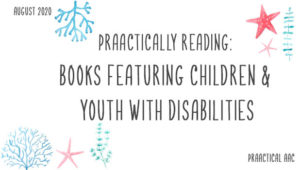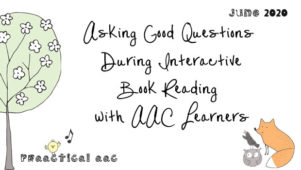5 Easy Ways to Add Authentic Writing Experiences to Your AAC Therapy

There is no substitute for systematic instruction in reading and writing for building specific skills. AAC learners need high-quality instruction and lots of it. Beyond that, though, there are many ways to infuse literacy practice into the regular routine in therapy and at home. Writing for authentic purposes refers to experiences that reflect the writing activities of people in their regular lives. Authentic writing builds fluency, promotes skill generalization, and helps to build one’s self-concept as a writer. Plus, it’s fun, motivating, and pretty easy to do. Here are some things we try to do to include authentic writing experiences into our AAC therapies.
1. Sign in and out of the therapy session or classroom: Every AAC learner can do this. If the traditional sign-in form then doesn’t cut it, then make up a special sheet that has the client’s name in traceable letters, a name stamp, or placing a name sticker on the sign-in sheet. Sign in and out at the start and end of each session and pretty soon you’ll have built the habit.
2. Send notes, cards, and e-cards: Sharing is motivational. Whenever something important, unusual, or nutty happens, write a note about it. Did something break or did you run out of supplies? Have the client help you write a note to whomever needs to know. Celebrations are good for this, too. Birthdays, holidays, Awareness Days, anniversaries: it’s all fodder for authentic writing. Depending on their skill level, the client may be able to do a lot or just a little. Either way, get them actively involved.
3. List Making: Everyone needs reminders from time to time and lists are a strategy that most of us use. Getting our AAC clients involved in making and reading lists is a fun and functional way to get in some additional literacy practice. We SLPs are organized, creative, and prolific. We make lists for everything: what we need to buy, what we need to tell someone, where we are going to look for our lost keys, reasons why we don’t want to go to work tomorrow, people we want to say hi to. Give us a topic/activity and we can come up with a way to incorporate list-making. And with a little tweaking, some of those can be made appropriate for our AAC learners. Let us list the ways…
4. Home-School-Therapy Communication: We love to have families involved in therapy sessions or at least have them observe. But it isn’t always feasible and it leaves out the teacher and school SLP. Most of us have had notebooks or some other system of keeping everyone in the loop. Sometimes, AAC learners can get involved in that by dictating what happened (talking in the past tense! building narratives!) or actually doing the writing (with a pencil, keyboard, or alternative pencil). Other learners can mark or circle a picture choice to show what they did that session or how they felt about it.
5. Label It: Pull out the label-maker and have your AAC learner help you get organized. Maybe they can spell the words themselves. If not, give them a model to work from. For clients that have the motor skills to do this, operating a label maker can be a lot of fun. I had one young lady who liked it so much that she wanted to use it for full sentences. I made her my Bulletin Board Helper and she labeled the photos that we were posting. The funny thing was that her MLU was longer with the label maker than it was with her SGD. One thing is for sure – these kids will always surprise you!
Do you have a fun and easy way to add in a bit of authentic reading and writing. We’re always looking for new ideas!
Filed under: PrAACtical Thinking
Tagged With: literacy, reading, writing
This post was written by Carole Zangari




